|
|
#1
|
||||
|
||||
|
I think I might have found an answer why Cobb and some of the other subject weren't printed with a Hindu back and some other mysteries in the set.
The answer might have been right in front of us, many of us have posted and started threads about most if not all the evidence but I never put all of the pieces together until now. It came to me when Greg and I were having a lengthy discussion on his thread about the T220 panels he purchased that make up close to a full sheet. So to start off we know from ads that ran in sporting life starting on July 3 that in the initial printing of the t206's were the Piedmont, Sovereigns and Sweet Caporal. [IMG] 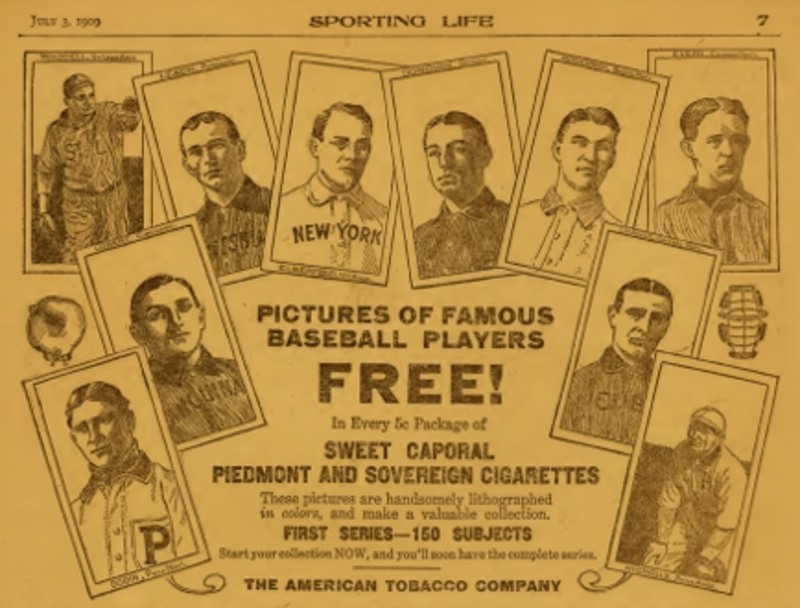 [/IMG] [/IMG]There were several Hindu ads in newspapers starting on August 2nd the initial ads pictured only the major league players [IMG]  [/IMG] [/IMG]in later ads they added the SL subjects [IMG]  [/IMG] [/IMG]So now lets discuss the printing and I'll use the print group 1 (150/350) subjects as an example because that's when the brown Hindu's were printed. There's sufficient evidence that each series was printed in stages and the sheet layouts and subjects changed within that series. One example is a two name card I have of Manning with Flick on the top. Manning was printed with a Sweet Caporal 150 factory 649 back but Flick wasn't so we know they weren't on the same sheet for the duration of the print group 1 printing. I think the Piedmonts were first to be printed at the start of each series 150/350, 350 only 350-460 ect... but I don't think they were always the first back printed in a stage I think that may have been determined by what the presses were set up for at the time. Here's an example of how the stages might have went in no particular order except the initial printing Initial printing of the T206's Piedmont - Sweet Caporal - Sovereign stage 2 Piedmont - Hindu major league subjects - Sweet Caporal 150/649 stage 3 Piedmont - Hindu SL's - Sovereign I think there were probably several stages as backs were added Now to why Cobb and some of the others weren't printed with Hindu backs and the answer lies in the Neal Ball letter [IMG] 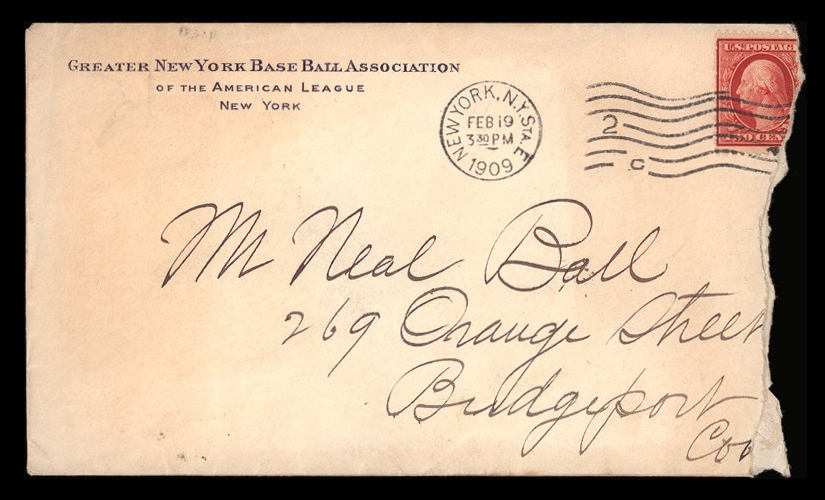 [/IMG] [/IMG][IMG]  [/IMG] [/IMG]In the letter Bulger it states the new law where they need the players permission to use their picture. The date the letter was mailed to Ball was February 19 1909 along with Cobb Ball is among the no prints with a Hindu back and I think it's because they didn't have his permission along with the other Hindu no prints at the time that the Hindu's were being printed. If you look at the Hindu's there are several subjects with two poses Ames Mordecai Brown Fred Clarke Evers Fielder Jones Lajoie Mathewson Tinker there are three subjects with 2 poses that are no prints Chase Cobb Keeler There are also 3 players with two poses that have a Hindu back pose and a no print pose McGraw Waddell Young now the explanation for these three could be A they already had a number that filled out the sheets for the size they were printing or B the permission for these three players came in late but in time for the Hindu printing or a combination of both in all three cases they used the portrait pose over the action pose. I've posted proof before that Cobb wasn't in the initial printing of the set [IMG]  [/IMG] [/IMG]more info on it can be found in this thread https://www.net54baseball.com/showthread.php?t=264260 Greg found a similar letter to the Ball letter for boxer Dick Hyland that he posted in his thread [IMG]  [/IMG] [/IMG]Now to Wagner, Plank and others In Greg's panels one of them has where someone at Brett Lithograph signed that they received it [IMG]  [/IMG] [/IMG]I think this is where some of the changes like Wagner, Plank, Magie and Doyle's could have been caught. These "proof sheets" ? were probably given to several people and the errors were probable caught early in one of the stages of the printings but not before some of them were already packed or sent out. I think other changes through out the whole set were probably made when they finally got permission from certain subjects Crawford and Jennings both from Detroit were added late to the group 1 subjects. All of this initially took place in the off season and maybe they were able to get permission from players like Crawford and Jennings when the season started in time for some stages of the printing but not the initial printing. Last edited by Pat R; 10-27-2021 at 06:51 PM. Reason: added info and corrected typo. |
|
#2
|
||||
|
||||
|
Here are a few examples of the point I'm trying to make about the stages using print flaws as an example.
Here's an Owen print flaws with the number of examples I found when I did the research on it. EPDG-3.jpg Owen.jpg The Piedmonts were probably printed in most if not all stages that's why the % of Piedmonts with the flaw is so much lower than the EPDG's. There were a number of vertical rows (around 10-12) of the same subject on each sheet but only 1 Owen in that row would have had this flaw and it was probably only there in the one stage where the EPDG"s and Piedmont's were printed together. Here are a pair of flaws that share similar numbers and were probably on the cards for two different stages. SC150-649-1.jpg Pastorius.jpg PD150-1.jpg Davis.jpg Here's a thread I posted on the print flaws several years ago https://www.net54baseball.com/showthread.php?t=215451 |
|
#3
|
|||
|
|||
|
Hi Pat,
I agree player authorizations can help explain T206 “no prints” (most obviously in the case of Honus) but since Hindu printing started *after* Pied and SC 150 printing one has to ask why, if lack of permission was the issue, all Hindu “no prints” were printed with Pied and SC 150. Is your contention that Hindu “no prints” were only printed with Pied and SC 150 in post-Hindu stages of the 150 series print run? Scot Last edited by sreader3; 10-27-2021 at 08:43 PM. |
|
#4
|
||||
|
||||
|
Quote:
Yes that's exactly my thinking that they were first printed with those backs in stage 2 or 3 for example. Last edited by Pat R; 10-27-2021 at 09:35 PM. |
|
#5
|
|||
|
|||
|
First, interesting stuff... thank you for posting.
As to Piedmont's and Sweet Caporal's but no brown Hindu's, consider that the printers just started putting cards out there, P's and SC's, and as a few players and others complained, that's when they started sending what we'd think of as 'Ball letters.' I concede a problem with that is the postmark of when the Ball letter went out... Pat, as I read along with what you'd posted, it occurred to me that we've always assumed that cards on a sheet would always have identical backs... It makes sense to me that they'd be that way, but it's an uncertain variable that I don't recall anyone considering. Surely all backs on a given sheet would be the same. |
|
#6
|
|||
|
|||
|
Quote:
ATC miscuts strongly indicate all cards on a sheet, of all the ATC sets, had the same back brand. |
|
#7
|
||||
|
||||
|
Here's a good example of a PD150 that would have been printed very late in the print group 1 150/350 printing.
It's a PD150 that a member posted in the two name thread a Konetchy with Jennings portrait on the top. Konetchy Jennings.jpg Konetchy was printed with a Hindu but Jennings was the last addition to the print group 1 subjects and the only 150 back he was printed with in the 150 series was Piedmont. So the Piedmont sheet this card came from would have been from close to or in the last stage printing of print group 1. |
|
#8
|
|||
|
|||
|
Interesting theory and consistent with the fact that all of the 150-only subjects (save for Honus) were printed with Hindu.
On the other hand, it seems possible that ATC obtained *all* necessary authorizations (including Cobbs) by mid-summer 1909 and sequenced the printing of subjects based on other reasons, i.e. availability of artwork. |
|
#9
|
||||
|
||||
|
Quote:
I haven't given it a whole lot thought beyond print group 1 yet and of course I'm not insinuating in any way that this would explain all the odd changes throughout the set but part of my thought is that at the start they had enough photo's for the first series but still need permission for some of them and then needed to obtain more photo's and permissions as they moved along with each series. We know they started the SL's early with the Hindu's and Old Mills then stopped for a period of time before printing them with the Piedmont 350's and Old mills. One thought was that they did the early printing of SL's with the Hindu's and Old Mills while they were waiting for the permissions they needed to move on to the next stage and finish out the series but they didn't get them in time to finish out the Hindu major league subjects as the originally planned. I haven't looked into it but maybe the way the new law was written they didn't have to have permission from the SL players or they already had all of them. They probably had permission and photo's for most of the series as they moved along after the first series but I think there could have been some that still came in late or that they couldn't get that were never included in the set. For instance if some came in late in the 350 only printing it would explain guys with odd back patterns like Rossman, Cross and McElveen and if a player that they wanted to get in the sets permission came in late they may have removed someone else to put that player in. Last edited by Pat R; 10-28-2021 at 06:30 AM. |
|
#10
|
||||
|
||||
|
I think this is the new law Bulger is referring to. I'm not sure if I'm reading it right but it seems like they wouldn't need permission if they already had the photo's. I'm not sure if they mean before 1905 or before October 1908. It appears they could have used an older photo of Plank or Wagner if they had one in their possession before a certain date and included them in the set without their permission.
The date on this is October 28th 1908 [IMG]  [/IMG] [/IMG]
Last edited by Pat R; 10-28-2021 at 07:01 AM. Reason: added info |
|
#11
|
|||
|
|||
|
Is there any evidence of money changing hands for permission to use players likenesses? I wonder if the off season letters were a last ditch effort to secure signatures they were unable to get in the clubhouses in 08. Simpler times for sure.
|
|
#12
|
||||
|
||||
|
Just thinking out loud, so I apologize if there are easy answers to these questions...
Why is the Bozeman Bulger letter on New York Highlanders letterhead? He didn't work for the team, did he? When was the Bulger letter first discovered, was it known back at the time, or in the decades after, or did it not come to light until more recently? Given the number of different subjects in the set, there should have been almost 400 of these letters either delivered in person at the ball park or through the mail. Is there a reasonable explanation as to why this is the only one that has been discovered to date? I am operating under the assumption that permission would have to have been granted (based on the 1908 law) for any likeness to be sold, with not only cigarettes, but also gum, candy, bread, etc. That would require many more signed letters of permission across major and minor league players, across many different sets and they would have to be held on file at multiple different firms (American Tobacco, American Lithography, as well as various candy manufacturers, etc.). If it was just American Tobacco (or American Lithography), I guess they could have all been destroyed/thrown away at the same time. How likely is it that all of these signed letters would suffer the same fate across many different companies? Adding on, based on a quick Google search The letter was owned at one time by Barry Halper. Weren't there some items that Halper owned that were later discovered to have been forgeries? Is it possible for the envelope and letterhead to be real, but the actual content of the letter to be a fake? By that I mean, the envelope and they letter down to "Dear Neil," as genuine. Are there any examples of Bulger's signature that can be compared to the letter? Again, I am just thinking out loud and do not have any ax to grind here, no need to fire arrows at me 
__________________
___________________ T206 Master Set:103/524 T206 HOFers: 22/76 T206 SLers: 11/48 T206 Back Run: 28/39 Desiderata You are a child of the universe, no less than the trees and the stars; you have a right to be here. And whether or not it is clear to you, no doubt the universe is unfolding as it should. With all its sham, drudgery, and broken dreams, it is still a beautiful world. Strive to be happy. Last edited by wolf441; 10-28-2021 at 08:48 AM. Reason: Actually doing a little bit of research... |
|
#13
|
|||
|
|||
|
Quote:
Plank is complicated by having 150 and 350 series backs, but perhaps Wagner signed a letter like the one sent to Hyland that doesn't mention or imply tobacco whatsoever. If he signed, they would include him and he may then have protested if he was anti-tobacco once he found out what they were really doing. One possibility. |
|
#14
|
|||
|
|||
|
No evidence of payment, the letters imply to me there was none.
|
|
#15
|
|||
|
|||
|
Quote:
Permission was to the lithographer and not ATC, so other sets they did could have used these likenesses. Presumably some of the smaller sets by other companies simply ignored the law and flew under the radar. The letters appear to have been from the lithographic companies that produced the ATC set, on behalf of American Lithographic and Brett Lithographic. They were presumably then given to the ATC, as ATC was the defendant in the Porter case dealing with his letter and not one of the lithographic companies. Most of them would disappear together because they were probably filed together. Over 99.9% of internal documentation on these cards has disappeared, there is no wealth of paperwork. We have 1 partial ledger, 1 possibly full ledger, these two contracts, a handful of uncut panels and strips from non-baseball sets and... I think that is it on all the ATC sets production, development and printing. I am a sceptic, but believe the Ball letter is genuine. I see no evidence for forgery, Halper wasn't a forger he got duped as a buyer on some game-used material. It lines up with other evidence that surfaced later; if it was a fraud from this time it likely would reference ATC more directly and not the lithographer, and a more compelling name than Neal Ball would be chosen for $$$. |
|
#16
|
||||
|
||||
|
Quote:
I agree that the smaller companies could have ignored the law. And if the letter was on behalf of the lithographers, it would make sense that there would be fewer of them needed than if they had to be obtained by each individual tobacco, candy, gum firm that included them with their products. I thought about the fact that the letter was from an fairly average player, rather than one of the stars of the day. But, if you were trying to make a convincing forgery, wouldn't that be the type of player that you would choose? Also, the all of the facts around the 1912 article dealing with Honus Wagner's refusal to grant permission to use his image were well known by the 1980's. So the content of the letter is not sufficient proof that it is not a forgery. Is there an explanation as to why it is on New York Highlanders stationary? I am not arguing that the letter is a forgery, I'm just trying to understand how this letter survived where no other copies have every been discovered. If they had to get sign off from everyone in the set, you would think that in some cases, they would have had to send more than one letter if players did not respond to the first request. Why have no copies come to light when the personal effects of the players of the time were sold off by family members in the decades after the cards were issued?
__________________
___________________ T206 Master Set:103/524 T206 HOFers: 22/76 T206 SLers: 11/48 T206 Back Run: 28/39 Desiderata You are a child of the universe, no less than the trees and the stars; you have a right to be here. And whether or not it is clear to you, no doubt the universe is unfolding as it should. With all its sham, drudgery, and broken dreams, it is still a beautiful world. Strive to be happy. |
|
#17
|
|||
|
|||
|
The Ball letter could possibly have been faked, removing ink and retyping with am old typewriter etc.
The points against that are many. At the time Halper would have gotten it, it would have been a cool but not important item from a non- star player. The nuisance of faking a worn letter to a player from a non- player would make no economic sense. The item they would have had to clean to create it would probably have been worth more. Get an actual letter to Ball on NY stationery Clean off existing content Find an old typewriter or two... It looks like the main letter was a form letter and the name added. Add different content. So much work so little return.... Well into the 1990's, I could regularly find letters from somewhat notable people for under $5. Probably still can, it's just a little less common. Bulger was a sportswriter, and if I recall correctly, at the time sportswriters covering baseball were very close to the team. Perhaps even paid by the team at times. Sort of a PR function where the paper employed them to cover other things during the off season. So the letterhead doesn't surprise me at all. |
|
#18
|
|||
|
|||
|
So few survived because of the way they're made.
The permission slip is part of the original letter. Like Hyland, most were probably returned complete and filed in Either ALC or Bretts offices. As for ones not dealt with, how much of your junk mail do you keep? All the letters from credit card companies offering a card, or from places asking for donations... I collect stamps, so I save more than most and the amount I send to recycling is not all that trivial. |
|
#19
|
|||
|
|||
|
Lots more great info has come out on the T220 thread.
Like Brett Litho and ALC being close enough that Brett probably printed some T206s. And that Brett was using a type of press I hadn't heard about as one used on paper stock, One that was MUCH faster than the Hoe company flatbed presses ALC was (Mostly?) using. There was also a thing that gave us the probable size of the physical sheet for actress silks and most likely the baseball ones as well. AND the way they describe the stock required would seem to indicate a press that was not sheet fed, but rather printed from rolls of material. (Web fed) The clear but usually minor art differences within the series not only are very likely to support Pats idea here, but also would be the result of slight differences between printers. Very much like most sets from the early 1990's, where we see slight differences on so many cards and often differences that affect entire sets. So much to think about! |
|
#20
|
|||
|
|||
|
Quote:
By consistent with the later evidence I am not referring to Wagner at all. In that time the hobby was focused on the tobacco companies and not the printers, it is consistent with the information we have gleaned since from other sources. A forgery would likely be on behalf of the ATC, as it is only very recently we have begun to understand that the lithographers played a much more active role in these sets than just printing them for ATC. I agree with Steve, this is hardly the first letter from a sports writer on team letterhead, kickbacks from the team were common and the press was usually in bed with the team ownership. It doesnt seem out of place to me. Also makes sense the team would be supportive: its free advertising. The survival rate isnt a red flag, I think. How many printing stones and plates from the ATC sets have been found? How much other internal documentation? Its almost none. I wouldnt expect these letters, fairly insignificant at this time, to survive in greater quantity than other documentation has. I am a big fan of skepticism, separating fact from probability from personal opinions. We cannot say beyond any doubt the letter is genuine, but it is more reasonable to think it real than to think it a clever forgery, as there is no evidence for the later. |
|
#21
|
||||
|
||||
|
Quote:
I suppose I am probably giving to much attention to the material based on what we know 100+ years later, but you are right, 99.999% of stuff like this probably wound up in the trash or fireplace.
__________________
___________________ T206 Master Set:103/524 T206 HOFers: 22/76 T206 SLers: 11/48 T206 Back Run: 28/39 Desiderata You are a child of the universe, no less than the trees and the stars; you have a right to be here. And whether or not it is clear to you, no doubt the universe is unfolding as it should. With all its sham, drudgery, and broken dreams, it is still a beautiful world. Strive to be happy. |
|
#22
|
||||
|
||||
|
Quote:
It would be cool if we knew where the Ball letter came from when it was originally put up for auction. Was there any mention as to who sold/consigned it when it originally surfaced and how it came to be in their possession?
__________________
___________________ T206 Master Set:103/524 T206 HOFers: 22/76 T206 SLers: 11/48 T206 Back Run: 28/39 Desiderata You are a child of the universe, no less than the trees and the stars; you have a right to be here. And whether or not it is clear to you, no doubt the universe is unfolding as it should. With all its sham, drudgery, and broken dreams, it is still a beautiful world. Strive to be happy. |
|
#23
|
|||
|
|||
|
Quote:
I've only seen one stone with a card, and that was for one of the Canadian hockey sets. And at that, it was a master that transfers would have been printed from rather than a production stone. The production stones would have been resurfaced once they wore enough. And large ones did exist. But all the more reason to resurface as they were very heavy and expensive. I have a scan saved of one card that I need to find and put up that I believe shows the P350 stone was done on one of the scratched P150 stones. As it has a faint remnant of a scratch. Having just found out about the Aluminum plate rotary press being used on something besides tin, I'm not sure about what would have been done with the aluminum plates. The description makes it seem as if they were fairly thick, and if so they may have been resurfaced too. The ones I'm familiar with were very thin and coated and were just saved to be recycled. The smaller ones from the 12" press made great dustpans. |
|
#24
|
||||
|
||||
|
I not saying they could not have but if it was forged they would have either done some research or had knowledge of the change in the use of images law but still it seems like an odd thing to put in this letter if it was forged.
|
|
#25
|
||||
|
||||
|
Yeah, agreed. I guess misplaced skepticism on my part. Sorry to take the thread off track, Pat. Great information as always in terms of the progression of subjects from 150 to 350 across various backs.
__________________
___________________ T206 Master Set:103/524 T206 HOFers: 22/76 T206 SLers: 11/48 T206 Back Run: 28/39 Desiderata You are a child of the universe, no less than the trees and the stars; you have a right to be here. And whether or not it is clear to you, no doubt the universe is unfolding as it should. With all its sham, drudgery, and broken dreams, it is still a beautiful world. Strive to be happy. |
|
#26
|
||||
|
||||
|
No problem Steve, I didn't find anything wrong with questioning it.
|
|
#27
|
||||
|
||||
|
Adding to the stages theory, in different degrees there's usually a group of subjects that are tougher on a particular back than another group and sometimes there's yet another group that falls in the middle.
Just using the Old Mills for example because they were discussed recently with the print group 1 subjects. For instance lets say they were printed in three stages the group of tougher subjects would have only been on a sheet for one stage the middle group for 2 stages and the easier ones for all 3. Now if there the old mills were only printed in two stages it could be that there were a lot more sheets printed in one of the stages and the tougher group was printed in the short print stage the middle group in the long print stage and the easier group in both stages. This would also apply if they were printed in different facility's. |
|
#28
|
|||
|
|||
|
Quote:
So I think you are probably right about the Hindu “no prints” being printed at a late stage in the 150 series, and that might be due to late permissions; however, it might also be due to other factors. Last edited by sreader3; 10-28-2021 at 12:48 PM. |
|
#29
|
||||
|
||||
|
Quote:
Last edited by Pat R; 10-28-2021 at 12:49 PM. |
|
#30
|
|||
|
|||
|
Interesting discussion going on here. However, I have a different take on this subject.
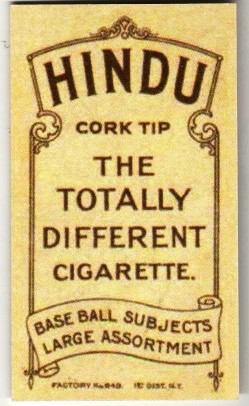 Looking at the bigger picture regarding the brown HINDU press run(s). American Lithographic Co. (ALC) printed 136 different subjects with the HINDU back. Thirty four Southern Leaguers and 102 Major Leaguers. Exactly how and when ALC printed them, we will probably never know. However, we do have insight into 34 of the HINDU cards, which were simultaneously printed with the SWEET CAPORAL 150 Factory #649 Overprint press run. Based on several transactions of the players in this group of 34, we can determine approx. the date when this group of cards were printed with the HINDU back. There are 155 different subjects comprising the 150 Series of the T206 set. Twelve subjects in the 150-only series, and 143 subjects in the 150/350 series. We know that ALC printed PIEDMONT 150 backs first in the 150 Series. Then followed with SWEET CAPORAL backs. HINDU backs were printed on 102 Major Leaguers. Here are 4 examples in the group of 34 (which I noted above there are more) that indicate approx. how early some of the HINDU press runs were...... Tom Jones..........traded to Detroit in Aug 1909 Jim Pastorius......released by Brooklyn in Aug 1909 Tubby Spencer....retired July 1909 Doc Powers........passed away April 1909 Therefore, my point is that most likely the Green Cobb and the Bat On Cobb were in later press runs of the 150 Series, so were simply left out of the limited HINDU press runs. TED Z T206 Reference . |
|
#31
|
||||
|
||||
|
Quote:
Your reference to the 34 subjects printed with the Hindu and SC649 backs is exactly what I'm proposing a sheet or sheets that was printed together in the same stage would have been probably with Piedmont 150 - Sweet Caporal 150/649 and Hindu. I think there were 156 subjects that were printed with 150 back. Last edited by Pat R; 10-28-2021 at 03:44 PM. Reason: Re-wording |
|
#32
|
|||
|
|||
|
Quote:
Pat You say "34-card" sheet....and I say "36-card" sheet. I shall repeat. American Lithograph's small size printing presses had 19-inch track widths, which were sufficiently wide to print 12 cards across the sheet....hence, 36, 48, 72, 96 card sheets. Therefore, such a sheet with 34 different subjects will have 2 double-prints included to fill-out that sheet. In the SWEET CAP 150 #649 case, my guess is that Johnson & Matty were double-printed. Just like when TOPPS Hi# sheet (97 different subjects) had Mantle, Robinson, and Thomson double-printed to fill out their 100-card sheet. In the Southern League case, it's anyone's guess which two players were double-printed. As a teenager, I worked in a Print Shop and I'm very familiar with printing practices. Come-on Pat, you're nit-picking again..... "I think there were 156 subjects that were printed with 150 back " I stated.... [B]"There are 155 different subjects"....that does not include the MAGIE error card. TED Z T206 Reference . |
|
#33
|
|||
|
|||
|
Quote:
|
|
#34
|
||||
|
||||
|
Quote:
https://photos.imageevent.com/patric...203%20Full.jpg Here's the front image of the Seymour and Cicotte that's pointed out in white on that sheet. [IMG]  [/IMG] [/IMG]
Last edited by Pat R; 10-28-2021 at 07:54 PM. Reason: added front image |
|
#35
|
|||
|
|||
|
Quote:
150-only Series American Lithographic introduced the T206 set during the Spring of 1909 by printing these 12 cards then shipped them to T-Factory's____  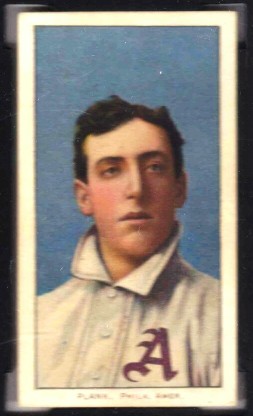 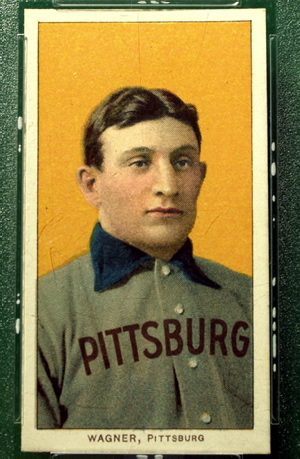  Southern Leaguers....48 subjects....(PIEDMONT 350 printed and issued 1910) Exclusive 12....printed and issued circa late 1910 - 1911) .. v ................................ 19" x 24" standard size sheet ...................................v 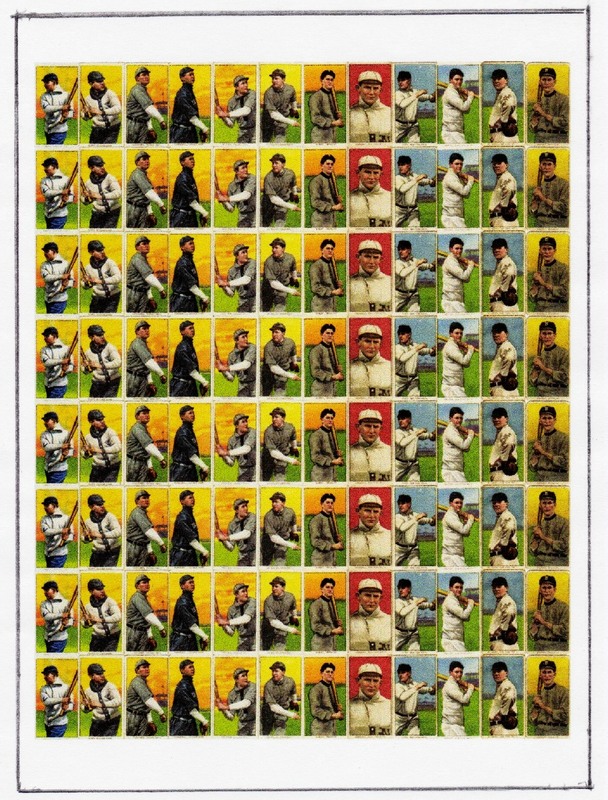 .... Simulated sheet of the T206 "Exclusive 12" subjects in the 460-only series T205 Minor Leaguers (12 subjects)......printed and issued late 1911         TED Z T206 Reference . |
|
#36
|
|||
|
|||
|
A multiple of 12 certainly makes sense for part of T206. But what is the evidence it is 12 and not 24, or some other figure, and that was consistent the entire year and a half of production? We've recently found a sheet from another ATC set of the period that appears to measure over 50 inches across. Perhaps they were only 19 inches wide, but I don't think I've seen evidence that supports this as a conclusion over one possibility of many. Happy to stand corrected.
|
|
#37
|
|||
|
|||
|
WOW.. very nice detective works here. Have you also look into the Hindu ledger page that was mentioned in this Cycle ledger page video?
https://www.youtube.com/watch?v=PXkDorcmidU&t=39s That Hindu ledger page have the right side tore off but not sure anyone actually own the other half, it would definitely help identify the actual Hindu shipment date etc. Keep up the good work team! |
|
#38
|
||||
|
||||
|
Quote:
I've never seen the other piece of the Hindu page there is a piece of one of the Sweet Caporal pages that was for the packing and shipping of the Sweet Caporals with separate packing and shipping instructions for Philadelphia. ATC Phila.jpg |
|
#39
|
||||
|
||||
|
Quote:
You continue to state this despite substantial visual proof that not all (if any)T206 sheets were printed using a 19 inch press. I've posted this before, one of the plate scratch sheets has three scratches on it one is a continuous scratch that goes all the way across the sheet and the other two scratches are partial scratches. All three scratches connect to the same subject. Here's what that sheet looks like on paper [IMG]  [/IMG] [/IMG]All of the subjects on this sheet are Hindu/SC150/649 subjects Here's what the front of that sheet looks like 0 Sheet 1B.jpg On this sheet Goode is next to Sheckard here's the actual scans of those two cards with their scratches [IMG]  [/IMG] [/IMG]Here's a Miscut SC150/30 Sheckard that shows Goode was definitely next to him on a sheet. [IMG]  [/IMG] [/IMG]There are several other plate scratch sheets that show a press larger than 19 inches was used in the T206 printing. |
|
#40
|
|||
|
|||
|
Quote:
|
|
#41
|
||||
|
||||
|
Thanks Greg, the best organized info on the plate scratches is in Luke's blog, there have been a few corrections and changes since he posted the articles on them but most of the info is still the same.
If this link doesn't take you to them you can type plate scratch in the search function and bring them up. http://www.thatt206life.com/?s=plate+scratch |
|
#42
|
|||
|
|||
|
Pats work on the scratches has been amazing. especially doing it with actual cards instead of just scans. I'd been working off saved scans for a while but stopped when I realized Pat had about twice as many cards as I had scans. (And all put together in less time too!)
I still think the short partial scratch on this sheet actually belongs to one side, probably the right. that would make a sheet 24 cards wide with an uneven distribution of subjects. The group of new information that's come together beginning with looking into the T220 silver sheets will change how we see things. The known track width at ALC is not necessarily material considering Brett Litho printing millions of cards for other ATC sets. Having done some quick math before, even Scot Rs low estimate for T206 production would have meant nearly constant printing more likely on multiple flatbed presses. The sheet rate of the rotary press really makes it a much simpler job. Even more so if they had a two color rotary press which there's a bit of evidence for. But there is also very solid evidence that some were printed on a flatbed press. That would indicate to me that T206 production probably happened at both ALC and Brett litho. (And possibly other places) It's all going to take some thinking and looking up stuff to sort out. |
|
#43
|
||||
|
||||
|
Pat are you thinking early sheets did not have a 50/50 split with 17 subjects on the top and 17 subjects on the lower half? We have seen a few of the 649 subjects with different subject names on top. Good example is Jamie's Lake/Pastorius card.

__________________
T206 gallery Last edited by atx840; 10-29-2021 at 11:25 AM. |
|
#44
|
||||
|
||||
|
This is awesome Pat. Thanks for posting it.
__________________
ThatT206Life.com |
|
#45
|
||||
|
||||
|
Quote:
Here's how I feel the sheets were printed as far as vertical subjects for each series. 150 backs - a mix of 2 vertical subjects and 1 vertical subjects with a higher % of 1 vertical subject. 350 backs - likely all 2 vertical subjects 350/460 backs - likely all 1 vertical subject 460 backs - likely all 1 vertical subject Here's a Powell with a plate scratch that SGC put in the holder upside down. I wish it was an upside down back but it's a name at top. [IMG] 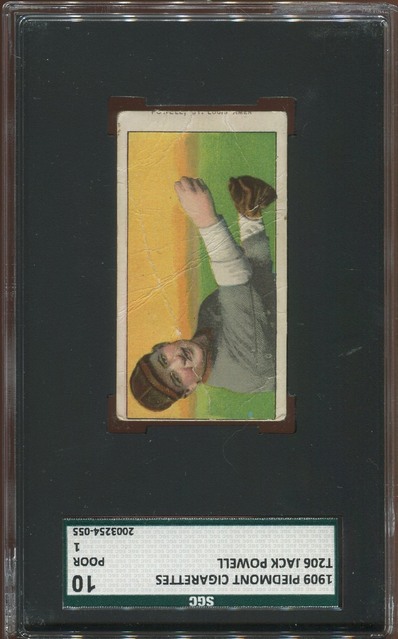 [/IMG] [/IMG]
Last edited by Pat R; 10-30-2021 at 02:40 PM. Reason: reduced Powell scan |
|
#46
|
||||
|
||||
|
I'm adding this here from the other thread. This new Old Mill Ad is enlightening at least to me I always thought the Old Mill brand was Older but the T206's
were a promotion in them as a new brand. Quote:
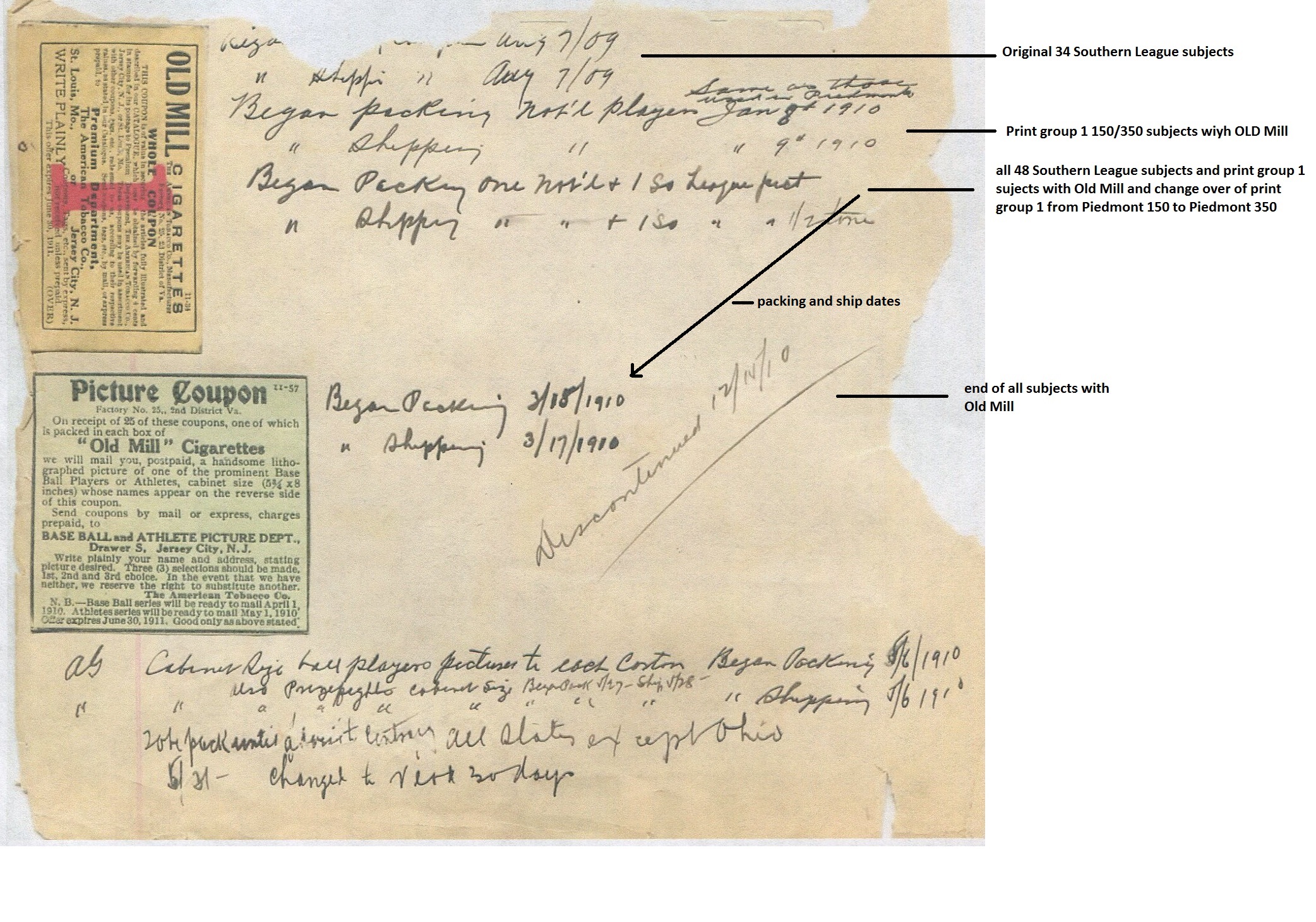 [/IMG] [/IMG]
|
|
#47
|
||||
|
||||
|
Fantastic work as always Pat.
Wish we had more of this error out there, wondering if a brown OM sheet was used as a test later on for the 649s. Need to spends some time looking into your timelines. 
__________________
T206 gallery |
|
#48
|
||||
|
||||
|
Quote:
Would the T206's and other cards have been printed on these Steve?  Here's the patent information on the multi color press that Hett invented and sold to American Lithograph. https://patentimages.storage.googlea...e/US637603.pdf |
|
#49
|
|||
|
|||
|
Quote:
The cards with the nail mark on the other hand are almost for sure a product of a flatbed press, as the nail would have been in the impression cylinder, and there's no reason a press with metal rollers would have a nail. |
|
#50
|
||||
|
||||
|
Quote:
[IMG]  [/IMG] [/IMG]What do you think about the possibility of some sheets having the fronts printed on this type of press and the backs printed on a different type press? |
 |
|
|
 Similar Threads
Similar Threads
|
||||
| Thread | Thread Starter | Forum | Replies | Last Post |
| FS: T206 Molesworth Brown Hindu back | T206DK | Tobacco (T) cards, except T206 B/S/T | 3 | 03-03-2013 02:03 PM |
| T-206 G. BROWN WITH HINDU BACK | Archive | Tobacco (T) cards, except T206 B/S/T | 2 | 03-14-2009 11:49 AM |
| F/S T-206 G. BROWN CHICAGO HINDU BACK | Archive | Tobacco (T) cards, except T206 B/S/T | 0 | 03-13-2009 09:54 PM |
| Brown Hindu back on T206s | Archive | Net54baseball Vintage (WWII & Older) Baseball Cards & New Member Introductions | 4 | 06-01-2007 11:22 PM |
| How much of a value multiplier is a Brown Hindu Back? | Archive | Net54baseball Vintage (WWII & Older) Baseball Cards & New Member Introductions | 6 | 06-06-2002 09:01 PM |